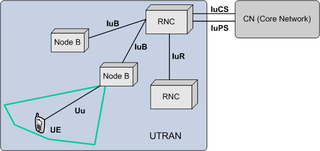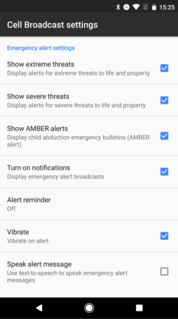Related Research Articles
The GPRS core network is the central part of the general packet radio service (GPRS) which allows 2G, 3G and WCDMA mobile networks to transmit IP packets to external networks such as the Internet. The GPRS system is an integrated part of the GSM network switching subsystem.
The Radio Network Controller (RNC) is a governing element in the UMTS radio access network (UTRAN) and is responsible for controlling the Node Bs that are connected to it. The RNC carries out radio resource management, some of the mobility management functions and is the point where encryption is done before user data is sent to and from the mobile. The RNC connects to the Circuit Switched Core Network through Media Gateway (MGW) and to the SGSN in the Packet Switched Core Network.
The IP Multimedia Subsystem or IP Multimedia Core Network Subsystem (IMS) is a standardised architectural framework for delivering IP multimedia services. Historically, mobile phones have provided voice call services over a circuit-switched-style network, rather than strictly over an IP packet-switched network. Alternative methods of delivering voice (VoIP) or other multimedia services have become available on smartphones, but they have not become standardized across the industry. IMS is an architectural framework that provides such standardization.
In telecommunications networks, RANAP is a protocol specified by 3GPP in TS 25.413 and used in UMTS for signaling between the Core Network, which can be a MSC or SGSN, and the UTRAN. RANAP is carried over Iu-interface.

UTRAN is a collective term for the network and equipment that connects mobile handsets to the public telephone network or the Internet. It contains the base stations, which are called Node B's and Radio Network Controllers (RNCs) which make up the UMTS radio access network. This communications network, commonly referred to as 3G, can carry many traffic types from real-time Circuit Switched to IP based Packet Switched. The UTRAN allows connectivity between the UE and the core network.
GPRS Tunnelling Protocol (GTP) is a group of IP-based communications protocols used to carry general packet radio service (GPRS) within GSM, UMTS and LTE networks. In 3GPP architectures, GTP and Proxy Mobile IPv6 based interfaces are specified on various interface points.
Multimedia Broadcast Multicast Services (MBMS) is a point-to-multipoint interface specification for existing 3GPP cellular networks, which is designed to provide efficient delivery of broadcast and multicast services, both within a cell as well as within the core network. For broadcast transmission across multiple cells, it defines transmission via single-frequency network configurations. The specification is referred to as Evolved Multimedia Broadcast Multicast Services (eMBMS) when transmissions are delivered through an LTE network. eMBMS is also known as LTE Broadcast.
Control plane protocol for the transport layer in 3rd Generation UMTS networks is called ALCAP. ALCAP is defined by 3GPP as equivalent of ITU recommendation Q.2630.2. Basic functionality of ALCAP is multiplexing of different users onto one AAL2 transmission path using channel IDs (CIDs). It is used in the UMTS access network UTRAN along with ATM, while IPBCP is use for IP links in the core of the network.
RNSAP is a 3GPP signalling protocol responsible for communications between RNCs Radio Network Controllers defined in 3GPP specification TS 25.423. It is carried on the lur interface and provides functionality needed for soft handovers and SRNS relocation. It defines signalling between RNCs, including SRNC and DRNC.
SRNC | DRNC | IUR | RNSAP | RNSAP | | |

E-UTRA is the air interface of 3rd Generation Partnership Project (3GPP) Long Term Evolution (LTE) upgrade path for mobile networks. It is an acronym for Evolved Universal Mobile Telecommunications System (UMTS) Terrestrial Radio Access, also referred to as the 3GPP work item on the Long Term Evolution (LTE) also known as the Evolved Universal Terrestrial Radio Access (E-UTRA) in early drafts of the 3GPP LTE specification. E-UTRAN is the initialism of Evolved UMTS Terrestrial Radio Access Network and is the combination of E-UTRA, user equipment (UE), and E-UTRAN Node B or Evolved Node B (eNodeB).

Cell Broadcast (CB) is a method of sending messages to multiple mobile telephone users in a defined area at the same time. It is defined by the ETSI’s GSM committee and 3GPP and is part of the 2G, 3G, 4G LTE (telecommunication) and 5G standards. It is also known as Short Message Service-Cell Broadcast (SMS-CB).

In telecommunications, a femtocell is a small, low-power cellular base station, typically designed for use in a home or small business. A broader term which is more widespread in the industry is small cell, with femtocell as a subset. It connects to the service provider's network via broadband ; current designs typically support four to eight simultaneously active mobile phones in a residential setting depending on version number and femtocell hardware, and eight to sixteen mobile phones in enterprise settings. A femtocell allows service providers to extend service coverage indoors or at the cell edge, especially where access would otherwise be limited or unavailable. Although much attention is focused on WCDMA, the concept is applicable to all standards, including GSM, CDMA2000, TD-SCDMA, WiMAX and LTE solutions.
System Architecture Evolution (SAE) is the core network architecture of mobile communications protocol group 3GPP's LTE wireless communication standard.
A Home Node B, or HNB, is the 3GPP's term for a 3G femtocell or Small Cell.
Proxy Mobile IPv6 is a network-based mobility management protocol standardized by IETF and is specified in RFC 5213. It is a protocol for building a common and access technology independent of mobile core networks, accommodating various access technologies such as WiMAX, 3GPP, 3GPP2 and WLAN based access architectures. Proxy Mobile IPv6 is the only network-based mobility management protocol standardized by IETF.
A Home eNodeB, or HeNB, is the 3GPP's term for an LTE femtocell or Small Cell.
TR-196 is a Broadband Forum technical specification. Its official title is "Femto Access Point Service Data Model." The purpose of this Technical Report is to specify the Data Model for the Femto Access Point (FAP) for remote management purposes using the TR-069 CWMP.
E-UTRAN Node B, also known as Evolved Node B, is the element in E-UTRA of LTE that is the evolution of the element Node B in UTRA of UMTS. It is the hardware that is connected to the mobile phone network that communicates directly wirelessly with mobile handsets (UEs), like a base transceiver station (BTS) in GSM networks.
QoS Class Identifier (QCI) is a mechanism used in 3GPP Long Term Evolution (LTE) networks to ensure carrier traffic is allocated appropriate Quality of Service (QoS). Different carrier traffic requires different QoS and therefore different QCI values. QCI value 9 is typically used for the default carrier of a UE/PDN for non privileged subscribers.
LTE-WLAN aggregation (LWA) is a technology defined by the 3GPP. In LWA, a mobile handset supporting both LTE and Wi-Fi may be configured by the network to utilize both links simultaneously. It provides an alternative method of using LTE in unlicensed spectrum, which unlike LAA/LTE-U can be deployed without hardware changes to the network infrastructure equipment and mobile devices, while providing similar performance to that of LAA. Unlike other methods of using LTE and WLAN simultaneously, LWA allows using both links for a single traffic flow and is generally more efficient, due to coordination at lower protocol stack layers.